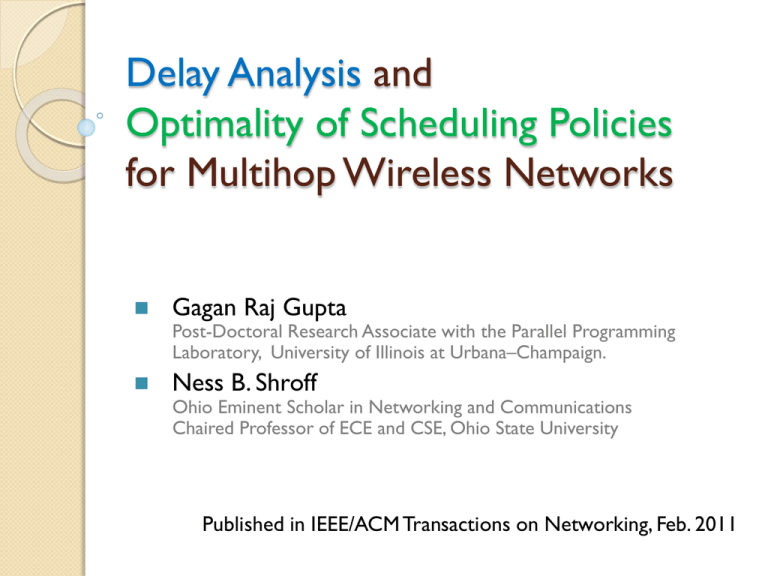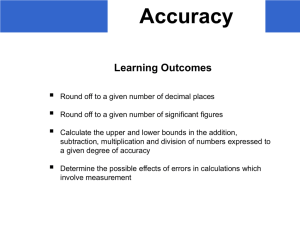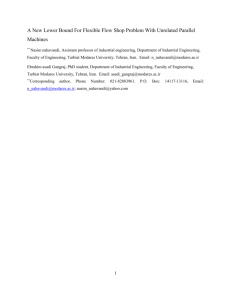PowerPoint **
advertisement

Delay Analysis and
Optimality of Scheduling Policies
for Multihop Wireless Networks
Gagan Raj Gupta
Post-Doctoral Research Associate with the Parallel Programming
Laboratory, University of Illinois at Urbana–Champaign.
Ness B. Shroff
Ohio Eminent Scholar in Networking and Communications
Chaired Professor of ECE and CSE, Ohio State University
Published in IEEE/ACM Transactions on Networking, Feb. 2011
Outline
Introduction
System model
Deriving lower bounds on average delay
Design of delay-efficient policies
Illustrative examples
Conclusion
2
Introduction
A large number of studies on multihop wireless
networks have been devoted to system stability
while maximizing metrics like throughput or utility.
The delay performance of wireless networks,
however, has largely been an open problem.
◦ the mutual interference inherent in wireless networks.
This paper presented a new, systematic
methodology to obtain a fundamental lower
bound on the average packet delay under any
scheduling policy.
3
Introduction (cont’d)
The delay performance of any scheduling policy is
primarily limited by the interference.
Many bottlenecks to be formed in the network
◦ The transmission medium is shared
◦ A bottleneck contains multiple links
4
Introduction (cont’d)
In this paper, the authors development of a new queue grouping
technique to handle the complex correlations of the service
process resulting from the multihop nature of the flows
◦ (K,X)-bottlenecks
Queueing model
5
System model
The service structure is slotted. Each packet has a
deterministic service time equal to one unit.
A(t)=(A1(t),…,AN(t)) : the vector of exogenous arrivals
◦ Ai(t) : the number of packets injected into the system by the
source si during time slot t.
=(1,…, N) : the corresponding arrival rate vector.
Pi=(vi0, vi1,…, vi|Pi|) : the path on which flow i is routed
◦ vij is a node at a j-hop distance from the source node
6
System model (cont’d)
The queue length vector is denoted by
Q(t) = (Qij(t): i=1,2,…N)
At each time slot, an activation vector I(t) is scheduled
depending on the scheduling policy and the underlying
interference model.
◦ Iij(t) indicates whether or not flow i received service at the j-th
hop from source si at time slot t.
7
(K,X)-bottleneck
We partition the flows into several groups.
◦ Each group passes through a (K,X)-bottleneck, and
the queueing for each group is analyzed individually.
(K,X)-bottleneck : a set of links X such that no more
than K of its links can be scheduled simultaneously
(K,X)-bottleneck G/D/K queue
8
Characterizing Bottlenecks in the System
1{iX} : indicate whether the flow passes through the
(K,X)-bottleneck.
The total flow rate X crossing the bottleneck X is
given by
Let the flow I enter the (K,X)-bottleneck at the node
viki and leave it at the node vili .
number of hops in bottleneck
9
Deriving lower bounds on average delay
The sum of queues upstream of each link in X at time t
is given by SX(t)
packet
Si1=1
packet
Si2=1
Si3=1
Si4=2
Si4=1
bottleneck
Si5=2
Si5=2
Si6=2
Si6=2
SX=6
SX=5
10
Reduced System
Let
be the queue length of this system at time t.
The queue evolution of the reduced system is given by
the following equation:
11
Bound on Expected Delay
delay from
vi1 to vili
delay from vili to vi|Pi|
where
12
Flow Partition
How to compute the lower bound on the average
delay for a system containing multiple bottlenecks ?
13
Flow Partition (cont’d)
Assume that we have precomputed a list of
bottlenecks in the system
Let Z be the set of flows in the system.
Let π be a partition on Z such that each
element p π is a set of flows passing through
a common (Kp, Xp)-bottleneck.
Our objective is to compute a partition π such
that the lower bound on can be maximized.
14
Flow Partition (cont’d)
Greedily search for a set of flows pP and the
corresponding (Kp,Xp)-bottleneck that yields
the maximum lower bound
15
Design of delay-efficient policies
Such a scheduler must satisfy the following
properties:
◦ Ensure high throughput
K
◦ Allocate resources equitably
Starvation leads to an increase in the average delay
in the system.
16
The clique network
A clique network is one in which
the interference constraints
allow only one link to be scheduled
at any given time.
◦ (1,X)-bottleneck
◦ Any work-conserving policy will achieve the lower
bound on SX.
◦ Note that a policy that minimizes SX may not
minimize the sum of queue lengths in the system at all
times, nor is it guaranteed to be delay-optimal.
17
The clique network (cont’d)
The optimal policy
◦ Last Buffer First Serve (LBFS)
Scheduling the packet that is closest to its
destination is optimal.
1-hop to dest.
2-hop to dest.
Delay time: 1, 3, 6
3-hop to dest.
Delay time: 3, 5, 6
18
Back-Pressure Policy
A throughput-optimal scheduling policy.
Define the differential backlog
of flow i passing
through a link
as
For each link, the flow with the maximum differential
backlog is chosen.
The link-scheduling component schedules the
activation vector with the maximum weight at every
time slot.
19
Back-Pressure Policy (cont’d)
20
Illustrative examples
Tandem Queue
The differential backlog at the last hop becomes comparatively
large for small values of , thereby increasing the relative priority
of the last link.
21
Illustrative examples (cont’d)
Simulation results for Tandem Queue
22
Illustrative examples (cont’d)
Clique
23
Illustrative examples (cont’d)
Dumbbell Topology
24
Illustrative examples (cont’d)
Tree topology
25
Illustrative examples (cont’d)
Cycle topology
K=2: X={1,2,3,4,5,6,7,8}
K=1: X1={1,2,3}
X2={6,7,8}
26
Conclusion
This paper develop a new approach to reduce the
bottlenecks in a multihop wireless to singlequeue systems to carry out lower bound analysis.
The analysis is very general and admits a large
class of arrival processes.
The analysis can be readily extended to handle
channel variations.
27
Comments
How to identify the bottlenecks in a wireless
mesh network ?
The analysis model can only obtain the lower
bound of “expected delay time”
How good is the lower bound ?
◦ especially when K is large.
28






